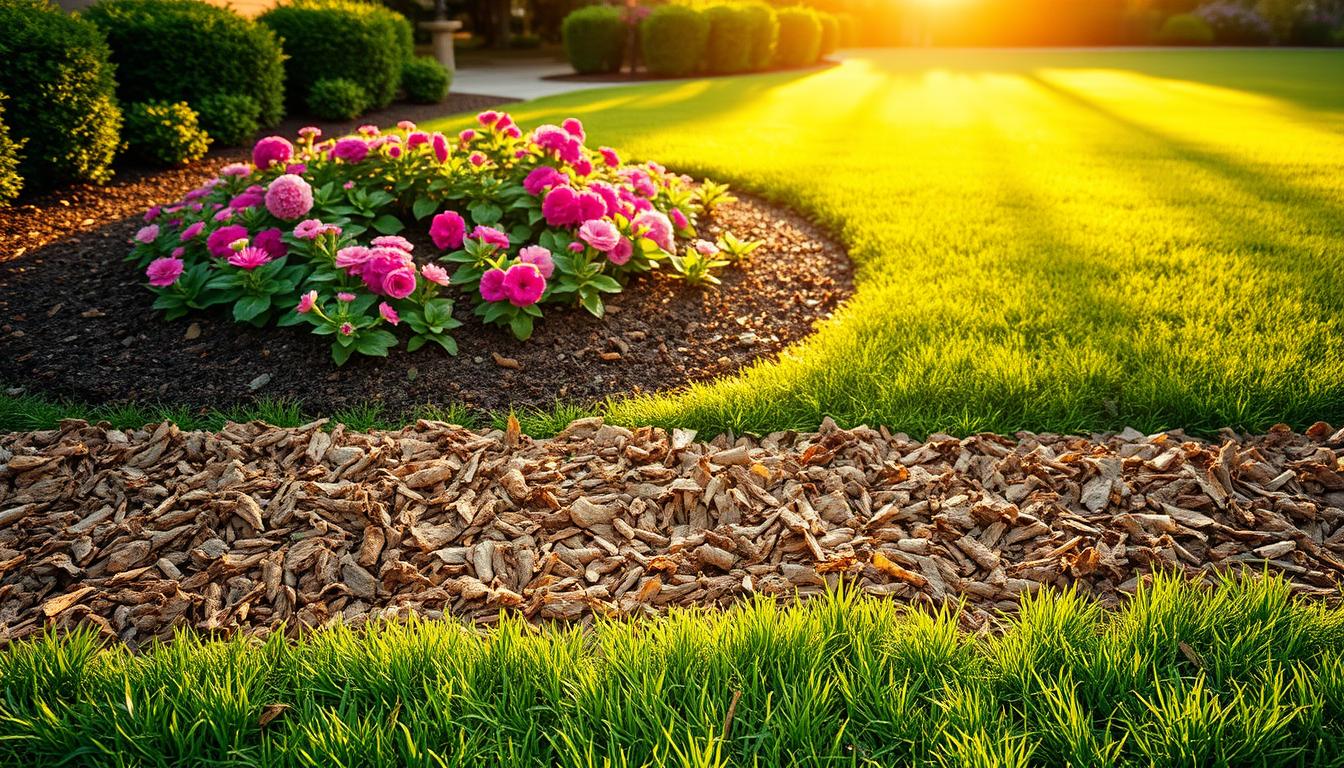Ever wondered why some lawns look perfect while others don’t? The answer often lies beneath. Smart lawn care experts know that mulching is key to a beautiful lawn.
Your lawn needs protection from extreme weather, to keep moisture, and to cycle nutrients. The right mulching can provide these benefits. Many homeowners focus on mowing and watering but overlook this important step.
This guide will cover everything from the basics to advanced strategies. You’ll learn which materials are best for different seasons. Plus, how to add these practices to your yard care routine.
Whether you’re new to lawn care or have been doing it for years, these tips will help. You’ll get a lush, vibrant lawn that needs less water, fewer chemicals, and less of your time.
Understanding the Power of Mulch for Lawn Health
Mulch is more than just a pretty layer on your lawn. It’s a key player in keeping your lawn healthy and strong. When used right, mulch brings many benefits that turn your lawn into a stunning green space. Knowing how mulch works helps you take better care of your lawn.
What Makes Mulch Essential for Vibrant Lawns
Mulch acts like a shield for your lawn, just like fallen leaves do in forests. It protects the soil and helps plants grow. Your lawn needs this kind of protection.
This layer stops soil from getting compacted by rain or people walking on it. It lets grass roots breathe and grow. Mulch also helps good bugs and microorganisms break down organic matter and release nutrients slowly.
Mulch keeps the soil temperature steady, which helps grass roots stay healthy in extreme weather. This keeps your lawn looking green and strong, even when it’s hard.
The Science Behind Mulch’s Effectiveness
Mulch works through complex soil biology, chemistry, and physics. As it breaks down, it feeds soil microbes. These microbes turn nutrients into forms grass roots can use.
This process makes the soil better for plants. It improves the soil’s structure, allowing for better water and air flow. This creates the perfect environment for grass roots to grow.
Mulch also helps adjust the soil’s pH over time. This makes the soil more neutral, which most grasses prefer. This is a big benefit for long-term lawn health.
Types of Mulch: Choosing the Right Material
It’s important to know the differences between various mulch types for your lawn. Each type has its own benefits that can help solve specific lawn problems. The right mulch can also match your landscape design.
Organic Mulch Options for Natural Lawns
Organic mulches come from plants and break down over time. They add nutrients to your soil. This natural process improves soil structure and protects your lawn.
Straw and Hay Mulches
Straw and hay are great for new lawns. They’re light and let seedlings grow while keeping the soil in place.
Straw mulch helps water soak into the soil but keeps it moist. It’s good for short-term use, lasting 1-3 months before adding to the soil.
Wood Chips and Bark
Wood mulches last longer and look good. Pine bark, cedar chips, and hardwoods keep weeds away for 1-3 years.
They break down slowly, perfect for established areas. Cedar and cypress also keep insects away, protecting your lawn.
Compost and Leaf Mold
Compost and leaf mold improve soil right away. They’re fine and mix into the soil quickly, helping plants grow.
They’re great for lawns with bad soil. They also make your garden look better by adding color and contrast.
Inorganic Mulch Alternatives and Their Benefits
Inorganic mulches don’t break down and solve specific problems. They need little replacement and look the same all year.
Stone and Gravel Options
Stone mulches are good for drainage and look great. River rock, crushed granite, and pebbles stop erosion and let water flow.
They’re perfect for areas where lawn meets hard surfaces. They’re cost-effective over time, even though they cost more at first.
Rubber Mulch Considerations
Rubber mulch is durable and keeps weeds away. It lasts 7-10 years with little care, ideal for consistent coverage.
But, it can get too hot in summer and doesn’t improve soil. It’s also made from recycled tires, which might be a concern for some.
Specialty Mulches for Specific Lawn Needs
There are mulches for special lawn needs. Erosion control mulches stay put on slopes. Colored mulches match your home’s look.
Insulating mulches protect against extreme weather. These mulches often mix different materials for specific lawn needs.
The Core Benefits of Strategic Mulching
Mulching is key to a healthy, beautiful lawn. It creates a protective layer that helps your lawn all year. Knowing these benefits helps you care for your lawn better.
Moisture Retention and Water Conservation
Mulch keeps soil moist, saving water. It can cut down evaporation by up to 70%. This means your lawn needs less water, even in summer.
It also helps your lawn stay green during dry times. This is because mulched lawns have stronger roots. These roots can find water when it’s scarce.
Weed Suppression and Management
Mulch stops weeds from growing. It blocks sunlight, stopping weed seeds from sprouting. This can cut weed numbers by up to 90%.
This means less time pulling weeds and fewer chemicals. Mulch also stops weeds from growing, making them easy to pull.
Soil Temperature Regulation Throughout Seasons
Mulch keeps soil temperature stable. It keeps soil cool in summer and warm in winter. This protects grass roots from cold.
This means your grass grows longer in spring and fall. You get more time to enjoy your lawn, and it stays healthy.
Nutrient Cycling and Soil Health Improvement
Organic mulches improve soil over time. They break down, adding nutrients to the soil. This helps soil microorganisms grow, making the soil better for grass.
As these microorganisms grow, they make the soil more fertile. This leads to greener grass and a lawn that’s more resilient to stress.
Mulching Techniques for Different Lawn Types
Knowing how to mulch your lawn depends on the type of grass you have. Different grasses need different care. By matching your mulching to your lawn’s needs, you can keep your yard healthy and beautiful.
Cool-Season Grass Mulching Approaches
Cool-season grasses grow best in cooler temperatures. They do well in spring and fall. Mulching them right supports their growth.
For cool-season lawns, use a thin layer of mulch in spring. This lets the grass get sunlight and stay moist. In summer, add more mulch to protect the roots from heat and save water.
Kentucky Bluegrass and Fescue Considerations
Kentucky Bluegrass lawns need extra care because their roots are shallow. Use mulch that holds moisture well, like compost or shredded leaves.
Fescue lawns have deeper roots. They need mulch that keeps the soil temperature steady. A mix of grass clippings and leaf mold is great for this.
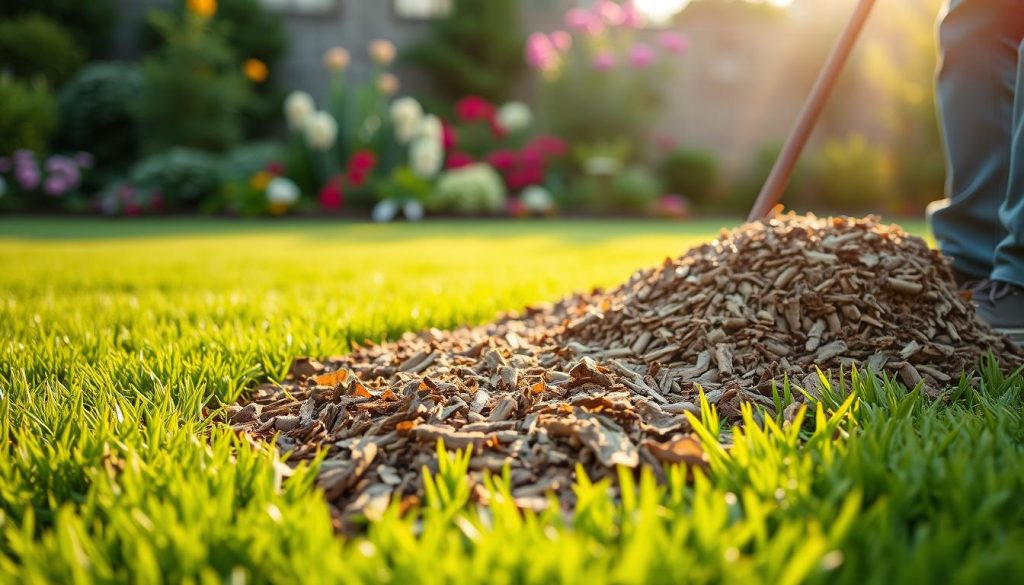
Warm-Season Grass Mulching Strategies
Warm-season grasses grow best in hot weather. They need mulching that helps them handle the heat.
For warm-season lawns, mulch in late spring when it’s warm. This helps them grow in summer and keeps weeds away. In winter, use a bit more mulch to protect the roots from cold.
Bermuda and Zoysia Grass Techniques
Bermuda grass spreads fast. Use fine mulch that doesn’t stop its growth. A mix of compost and pine straw works well.
Zoysia grass grows slower but is heat-tolerant. Mulch it to keep weeds away during growth. Use compost and pine needles for this.
Mulching for Mixed Lawn Varieties
Many lawns have more than one type of grass. Mulching these lawns needs a balanced approach. Use mulch that works for most grasses, like compost and shredded leaves.
Time your mulching to help the main grass type without harming others. Use a moderate amount of mulch to avoid smothering.
Regional Adaptations Across the United States
Where you live affects how you mulch your lawn. Climate, soil, and local challenges all play a part. Find the best mulching strategy for your area.
| Region | Recommended Mulch Materials | Optimal Timing | Special Considerations |
|---|---|---|---|
| Northeast | Leaf compost, grass clippings | Late spring, early fall | Focus on freeze-thaw protection |
| Southeast | Pine straw, composted cotton burrs | Early spring, mid-summer | Choose materials that resist fungal growth in humidity |
| Midwest | Straw, shredded leaves | Spring after last frost, fall before first freeze | Select materials that won’t blow away in wind |
| Southwest | Composted wood chips, gravel | Early spring, late fall | Prioritize moisture retention and heat reflection |
| Northwest | Aged bark, compost | Spring after soil warms, early fall | Choose materials that drain well in rainy conditions |
In dry areas like the Southwest, use mulching to save water. Use deeper layers and consider gravel where organic mulch breaks down fast.
In humid places like the Southeast, pick mulch that fights off fungus. Use thin layers of pine straw to avoid too much moisture.
Proper Mulch Application Methods
The secret to a thriving lawn is not just in the mulch you use. It’s also in how you apply it. Using the right techniques ensures your lawn gets the most from mulching. This can turn an ordinary yard into a lush, vibrant landscape that everyone will admire.
Determining the Ideal Mulch Depth
Finding the right mulch depth is key for a healthy lawn. Too little won’t help, while too much can harm your grass. It’s all about finding that perfect balance.
For overseeding or light top dressing, use ¼ to ½ inch of mulch. This helps seedlings grow while keeping the soil moist. For established lawns, a 1-2 inch layer is best. It protects without suffocating the grass.
In landscape beds and around trees, you can use 2-4 inches of mulch. This helps suppress weeds and retain moisture. Always keep mulch 2 inches away from plant stems and tree trunks to avoid rot and pests.
Application Patterns for Maximum Coverage
Landscapers use special patterns for even mulch distribution. The spiral pattern is great for circular areas like tree rings. For rectangular spaces, the row technique ensures even coverage.
Section techniques divide large areas into squares. This method helps keep the depth consistent across big lawns. Always smooth the surface with a rake for a neat finish.
Tools and Equipment for Efficient Mulching
The right tools make mulching faster and more effective. Your choice depends on your lawn size, mulch type, and personal preference.
Manual vs. Mechanical Application
Manual application is good for small areas and gives you control. Mechanical methods save time and effort for bigger properties but need practice.
For small to medium yards, basic garden tools are enough. A wheelbarrow moves mulch well, and a garden rake spreads it evenly. Gloves protect your hands, and a shovel or fork helps move mulch.
Specialized Mulching Equipment
Larger properties need specialized equipment for faster mulching. Mulch blowers cover big areas quickly. Power spreaders are great for finer materials like compost or grass clipping mulch.
| Tool Type | Best For | Pros | Cons |
|---|---|---|---|
| Garden Rake | Small areas | Precise control, inexpensive | Labor intensive, time-consuming |
| Mulch Fork | Medium areas | Better grip on chunky mulch | Less precise than rake |
| Mulch Spreader | Large flat areas | Even application, faster | Initial cost, storage needs |
| Mulch Blower | Professional jobs | Very fast, reaches difficult spots | Expensive, requires training |
When choosing equipment, think about how often you’ll use it. Renting might be cheaper than buying for annual mulching. Many garden centers offer rentals during peak seasons.
Seasonal Mulching: Timing Your Applications
A well-planned seasonal mulching schedule works with nature’s rhythms to help your lawn. Your grass changes with each season, so your mulching should too. Knowing when and how to mulch throughout the year keeps your lawn healthy, no matter the weather.
Spring Mulching for Growth Promotion
Spring is the best time to get your lawn ready for success. Mulch after the last frost but before summer heat hits—usually mid to late spring. This timing captures spring moisture and keeps temperatures moderate.
Use a ½-inch layer of mulch in spring to let grass blades get sunlight. Focus on areas damaged by winter or where soil needs more organic matter. Partially decomposed mulch is best in spring as it quickly releases nutrients for growth.
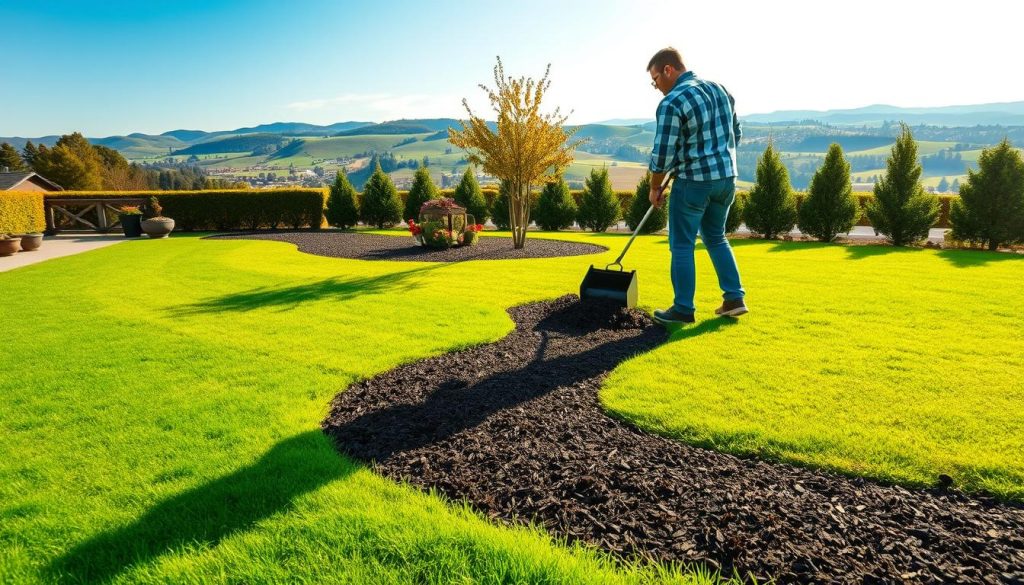
Summer Mulching for Heat Protection
Summer mulching protects your lawn from heat and drought. Apply a fresh layer in early summer before it gets too hot. Use a 1-inch layer to insulate while still allowing air to circulate.
Do mid-season touch-ups in July or August for heat-stressed areas. Spread mulch gently in active growth periods to avoid damaging turf. Water well after application to help the mulch settle and start protecting your lawn.
Fall and Winter Mulching for Cold Weather Defense
Fall mulching extends the growing season and prepares your lawn for winter. Apply mulch in early to mid-fall when temperatures cool but before the first frost. This helps soil retain warmth longer and protects roots from sudden drops.
Use coarser materials for winter insulation, as they break down slowly. A 1 to 1.5-inch layer is ideal for most lawns. The slow decomposition of fall mulch also feeds your soil nutrients during winter, readying it for spring.
Adjusting Schedules for Climate Zones
Your location affects the best mulching schedule. Southern areas with year-round growth may need quarterly mulching, focusing on summer heat. Midwestern and Northeastern lawns need heavier fall mulching for harsh winters.
Western states with drought should focus on water-retention mulching in late spring. Watch local weather and adjust your schedule for unusual events. Climate change may require shifting your traditional timing as regional patterns change.
Linking mulching with other lawn care activities boosts its benefits. Schedule mulching after aeration but before fertilization for best soil health. This integrated approach ensures your mulching is part of a comprehensive lawn care strategy that adapts with the seasons.
Grass Clipping Mulching: Recycling Your Lawn’s Resources
Grass clipping mulching is like nature’s recycling system. It turns waste into a valuable resource for your lawn. This practice helps your landscape and the environment by returning nutrients to the soil.
Benefits of Grass Cycling
Leaving grass clippings on your lawn after mowing is beneficial. It can provide up to 25% of your lawn’s nitrogen needs. This reduces the need for fertilizers and saves money.
Grass cycling also cuts down on waste sent to landfills. Yard waste is a big part of municipal solid waste. Plus, you won’t have to spend time bagging and disposing of clippings.
Proper Techniques for Grass Clipping Mulch
Optimal Cutting Height for Mulching
The right cutting height is key for grass cycling. Cut no more than one-third of the grass blade length each time. This size is perfect for quick decomposition without harming the lawn.
Adjust your cutting height with the seasons. Keep it higher in summer to protect roots and lower in fall to prevent matting. Cool-season grasses need 2.5-3.5 inches, while warm-season grasses prefer 1.5-2.5 inches.
Mulching Mower Settings and Usage
A dedicated mulching mower is best. It has blades that cut clippings multiple times before returning them to the lawn. If you have a standard mower, consider a mulching kit for better results.
Keep your mower blades sharp and mow at a moderate pace. This ensures thorough processing of clippings. Regularly clean the deck to avoid efficiency loss.
Avoiding Common Grass Clipping Mistakes
Never mulch when the grass is too wet. Wet clippings can smother the grass and cause disease. Mowing too infrequently leads to long clippings that decompose slowly and may form thatch.
If clippings clump, try double-cutting or mowing when the lawn is dry. For lawns with thatch, collect clippings until the issue is fixed through aeration and dethatching.
Mulching Around Trees and Garden Beds in Your Lawn
Mulching around trees and garden beds is both useful and pretty. It makes your lawn look better and helps plants grow strong. Knowing how to mulch in different areas is key.
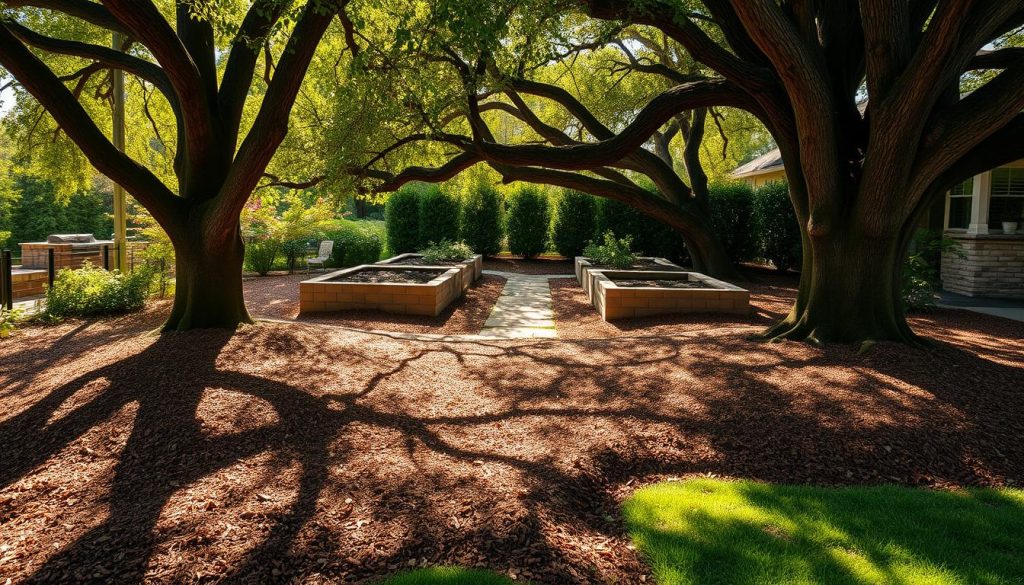
Creating Effective Mulch Rings Around Trees
Mulch rings around trees act like a natural blanket. They keep grass from competing with trees for water and food. Make sure the mulch goes up to the tree’s drip line.
Proper Distancing from Trunks
Keep mulch 3-6 inches away from tree trunks. This stops diseases and pests and keeps roots healthy. Think of it as a donut shape, not a volcano.
Depth Considerations for Tree Health
Young trees need 2-3 inches of mulch to grow well. Older trees can handle 3-4 inches, but no more. Too much mulch can hurt roots.
Transitioning Mulch Between Lawn and Garden Areas
Use edging to blend mulched beds with lawn. Metal, stone, or plastic edging works well. For a natural look, thin the mulch as it meets the lawn.
Lower the soil in garden beds to keep mulch in place. This stops it from spreading during rain or wind.
Specialized Techniques for Landscape Features
Be careful with mulch near water features. Use bigger mulch like river rock to avoid clogging. On slopes, use special mulch or blankets to stop erosion.
Keep mulch away from patios and walkways. Use contrasting mulch colors to make plants stand out.
Avoiding Common Mulching Mistakes
Mulching can be very beneficial, but it can also harm your lawn if done wrong. Knowing the common mistakes helps you use mulching to improve your garden. Even experienced gardeners can make these errors, but with the right knowledge, you can avoid them.
The Dangers of Over-Mulching
Too much mulch can smother your soil and plant roots. When mulch is more than 2-3 inches deep, it blocks oxygen from reaching the soil. This creates a bad environment for harmful fungi and pathogens.
Also, too much mulch stops water from soaking into the soil. Water might run off instead of being absorbed, leaving your lawn and plants dry. To fix this, remove the extra mulch until it’s the right depth.
Improper Material Selection Issues
Choosing the wrong mulch can cause problems. Fresh wood chips and sawdust take nitrogen from the soil as they break down. This can make your lawn look yellow and weak until the nitrogen levels are balanced.
Some mulches may bring weed seeds or harmful chemicals into your garden. Always check what your mulch is made of before using it.
Timing and Application Errors to Avoid
Applying mulch at the wrong time can be a mistake. Mulching too early in spring keeps the soil too cool, slowing down plant growth. Mulching too late in fall can attract pests that harm your lawn.
Uneven mulch distribution can also be a problem. Before you apply mulch, make sure the soil is ready. Remove weeds and loosen the soil to help the mulch work as it should.
“Volcano Mulching” and Other Harmful Practices
“Volcano mulching” is when mulch is piled high against tree trunks. This traps moisture and can cause rot and attract pests. It can even kill the tree.
Another mistake is mixing different mulch materials. This can lead to uneven breakdown and nutrient imbalances. Stick to one type of mulch in each area for the best results.
| Common Mistake | Consequences | Solution | Prevention Tips |
|---|---|---|---|
| Over-mulching | Root suffocation, fungal growth, water runoff | Remove excess to maintain 2-3 inch depth | Use depth markers when applying fresh mulch |
| Volcano mulching | Bark rot, pest infestation, tree decline | Pull mulch away from trunks, creating a donut shape | Maintain 3-6 inch clearance around all woody stems |
| Using fresh wood chips | Nitrogen depletion, yellowing lawn | Compost wood chips before application | Choose properly aged mulch materials |
| Improper timing | Delayed growth, pest habitation | Follow seasonal guidelines for your region | Mark calendar with appropriate mulching windows |
Advanced Mulching Techniques for Problem Areas
Problem areas in your lawn need special mulching strategies. These strategies tackle challenges like erosion, shade, and drought. With the right approach, even tough spots can flourish.
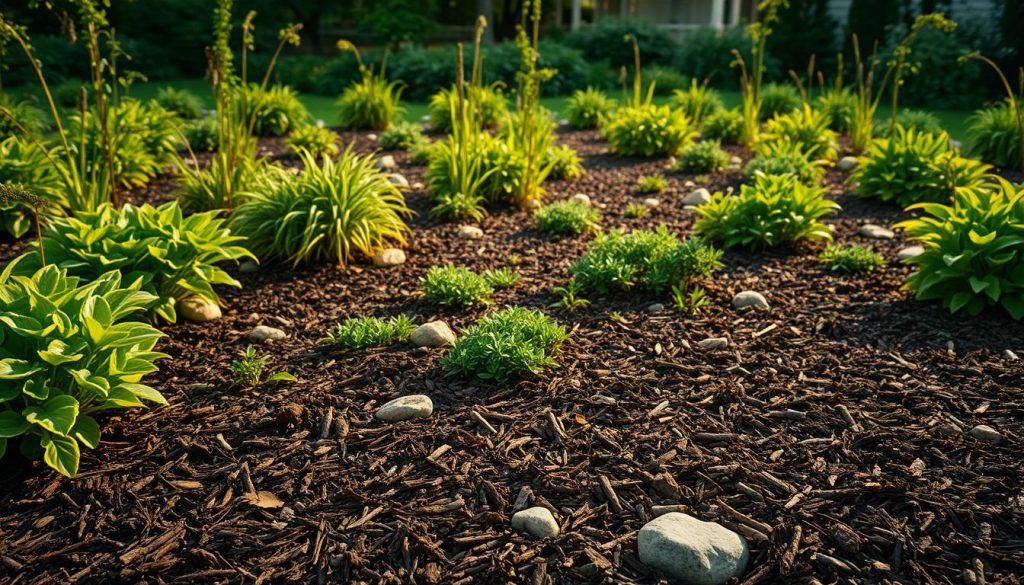
Mulching Solutions for Sloped Lawns
Sloped areas are hard to maintain because of erosion. Mulching can stabilize these areas and help grass grow.
Erosion Control Techniques
For slopes, mix mulch with structural elements to stop erosion. Make mulch berms to slow water runoff. These berms catch soil before it’s washed away.
Use erosion control blankets under your mulch. These blankets hold soil in place and let grass grow through. They protect your lawn while it gets stronger.
Stabilizing Mulches for Inclines
Not all mulches work well on slopes. Use interlocking mulch products to resist movement. Heavier materials like wood chips stay put better than straw or pine needles.
Apply a tackifier to keep mulch in place during storms. This organic adhesive is great for steep slopes where regular mulch might slide.
Techniques for Shady or Wet Areas
Shaded and damp areas need mulches that resist compaction and fungal growth. Choose coarse materials like pine bark nuggets for better airflow. Apply mulch about 2 inches deep to avoid moisture issues.
In wet zones, create a slight crown in your mulch to direct water away from plants. This helps prevent root rot and fungal diseases.
Addressing Soil Deficiencies Through Mulching
Mulch can fix problematic soils. For compacted areas, add compost beneath the mulch to improve soil structure. Use alkaline mulches like hardwood bark in acidic soils to adjust pH levels.
For nutrient-poor areas, use nitrogen-rich mulches like decomposed leaves or grass clippings. These break down quickly, feeding the soil and supporting lawn growth.
Drought-Resistant Mulching Strategies
Water-restricted areas benefit from deep mulching to retain moisture. Apply a 3-4 inch layer of organic mulch to reduce evaporation. Create slight depressions around plants to capture rainfall.
Use mulching with xeriscaping by grouping plants with similar water needs. This practice, called hydrozoning, focuses mulching efforts for better water conservation.
Combining Mulching with Other Lawn Care Practices
Mulching and other lawn care practices can make your yard better with little effort. When you use them together, they create a strong maintenance plan. This plan makes your lawn better and saves you work.
Integrating Mulching with Fertilization
Organic mulches slowly add nutrients to your soil, working well with fertilizers. This natural way of adding nutrients lets you use less chemical fertilizer. You can cut down on fertilizer by 25-30% without hurting your lawn.
For the best results, put fertilizer on before adding mulch in spring. This way, nutrients get to the soil right away. Mulch then stops fertilizer from washing away during spring rains. Pick fertilizers that match what your mulch adds, like nitrogen-rich ones with wood chip mulch.
Aeration and Mulching: The Perfect Partnership
Core aeration followed by mulching is great for your lawn. It fixes soil compaction and boosts organic matter and microbes.
After aerating, put a thin layer of fine mulch in the holes. This brings organic material deep into the soil. It helps water, air, and nutrients get to the roots, making your lawn healthier.
Watering Strategies for Mulched Lawns
Mulched lawns need different watering than bare soil. Mulch holds moisture, so you water less often but deeper.
Check soil moisture by lifting a section or using a moisture meter. Make sure sprinklers cover evenly, as mulch can cause water to run off. Many people water up to 30% less after starting good mulching habits.
Pest Management in Mulched Environments
Mulching changes how beneficial and harmful organisms live in your lawn. The right mulch encourages good bugs and microbes while keeping pests away.
Keep mulch at the right depth to avoid hiding pests. Use beneficial nematodes or other biological controls that do well in mulch. Cedar and cypress mulches keep many insects away, great for pest-prone areas.
By combining these practices, your lawn becomes more self-sustaining. Mulch benefits go beyond just applying it, making your ecosystem healthier. This means your lawn needs less care and looks better over time.
Your Path to a Vibrant Lawn: Long-Term Mulching Success
Learning mulching techniques is a journey, not a one-time task. Start with simple steps and see how your grass reacts. This way, you can adjust your methods based on real results, not just advice.
Make a mulching calendar that fits your local weather. Note the times of year when your lawn needs extra care. Cool-season grasses do well in spring and fall. Warm-season grasses need more help in early summer and before winter.
Take photos of your lawn every month. This visual record shows changes in color, density, and health. It’s great for spotting improvements in problem areas.
As your lawn grows, so should your mulching plan. Older lawns might need less but still benefit from regular, light mulching. This builds soil health over time, making your grass strong.
Good mulching means less need for chemical fertilizers and too much water. It saves time, money, and makes your outdoor space healthier. With patience and the right mulching, your lawn will grow strong and look beautiful for years.

